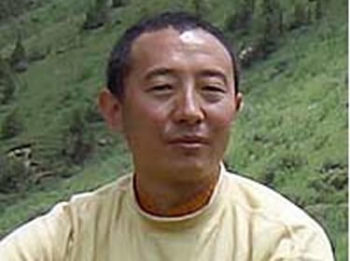Khenpo Samdup Rinpoche, Spiritual Director
Khenpo Samdup Rinpoche was born in Tibet and is a long time student of His Eminence Garchen Rinpoche. He studied the philosophy of the four schools of Tibetian Buddhism under numerous khenpos, such as Khenpo Munsel and Khenpo Jigme Phunsok. He taught for five years at Kagyu College in India founded by His Holiness Drikung Kabgyon Chetsang, from whom he received the vast teachings and transmissions of the Drikung Kagyu lineage. He has written a commentary on Jigten Sumgon’s Gong Chik – one of the significant philosophical texts of the Kagyu Lineage. He is currently the Dharma teacher at Gar Drolma Choling in Dayton Ohio, USA.
“I was born in Kham, in the Nangchen region of Eastern Tibet. When I was seven years old I received the vows of Refuge from Garchen Rinpoche, and at the age of twelve I became ordained as a monk. I learned how to perform lama dance and pujas, and to play various musical instruments and so forth. For three years I traveled every winter with Rinpoche making the rounds to over 15 or so different towns to hold great accomplishment practices, or drubchens. During the summers we would stay in retreat at the monastery in Gargon. Not long after that I had the great fortune of traveling with my kind root lama, Garchen Rinpoche to Amdo, where I met another extraordinary and highly realized lama, the Revered Dzogchen master Khenpo Munsel. From this great master I was able to receive direct pointing out instructions on the nature of mind. From these experiences I found that my mind had been deeply transformed.
Later I heard about the great qualities of the master Khenpo Jigme Puntsok, and I gave rise to a strong longing to meet him. So before long I set out on a challenging journey alone to Khenpo Jigme Puntsokís monastery in Amdo, hoping I would finally be able to devote myself to study, contemplation, and meditation. It was a far distance away and at that time in Tibet the condition of the roads was very bad, so there were very few people traveling that way. It ended up taking me over a month to get there. When I arrived I found that I was much younger than most of the monks and I had great difficulty understanding and communicating because my dialect was so different. There was practically nobody there from my region at that time so I was quite alone and without any friends. There are plenty of amusing stories I could tell from those times, but I wonít get into those here.
I was however able to meet with Khenpo Jigme Puntsok and I received many pith instructions, empowerments and teachings. I also was able to receive teachings on almost all of the Twelve Great Scriptures from his main student Khenpo Tsultrim Lodro. I stayed at Khenpo Jigme Puntsokís for more than four years.
Prior to my experience with Khenpo Munsel I had faith and devotion, but I was lacking understanding. And in order to grasp the profound meaning of the practices based on the pith instructions it is important to develop certainty with respect to the meaning of the teachings on The Middle Way. Now I knew that my practice of the Dharma had been based on blind faith, so from this point on I became especially interested in the study of Buddhist philosophy, and particularly the topics of Buddhist logic, reasoning, and the teachings of The Middle Way. I came to understand that through study and contemplation there arises a faith thatís based on reason. The main objective of Buddhism is to reach the state of liberation and complete omniscience, and the path that accomplishes that objective is the conduct of love and compassion, and bodhicitta, together with the view of emptiness and karmic interdependence. I felt determined to apply myself to the practice of study, contemplation, and meditation.
My own studies however still were not over. Later I would go on to study for four years at Dzogsar Shedra and then went on to Kagyu College where I received a graduate degree and taught for five years.” – Khenpo Samdup Rinpoche
The video below was taken in Vārāṇasī in northern India, where Buddha set in motion the Wheel of Dharma by delivering his first sermon to the group of five companions with whom he had previously sought enlightenment.


